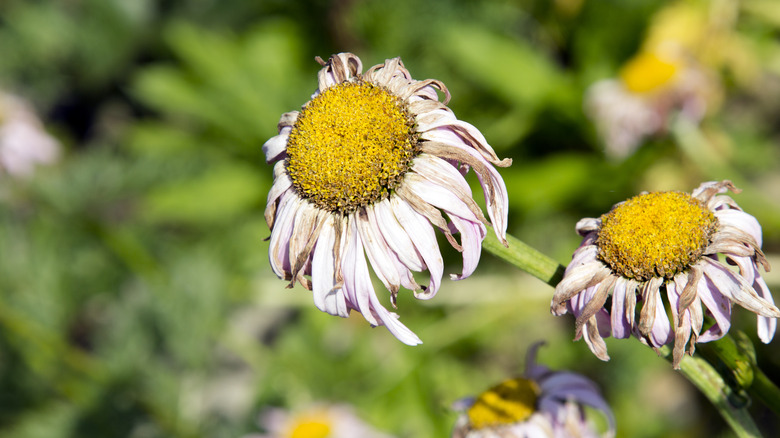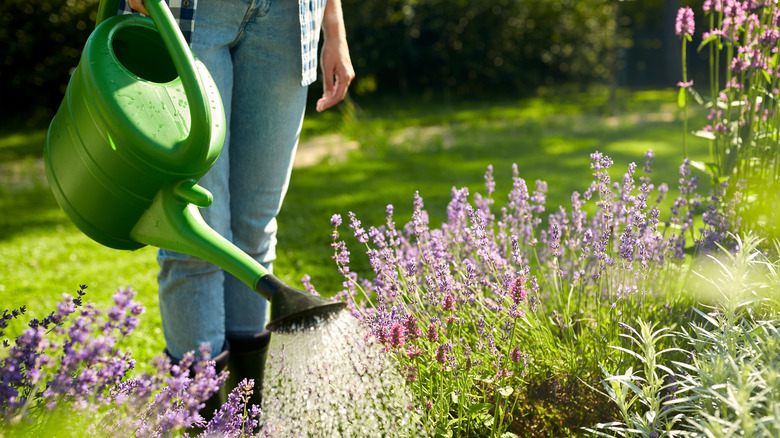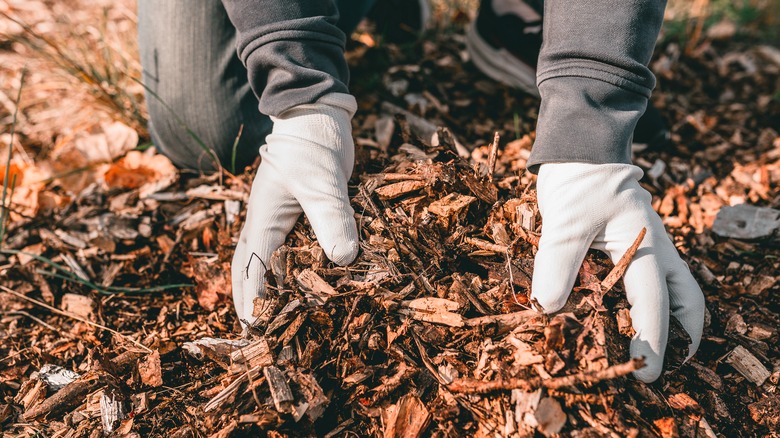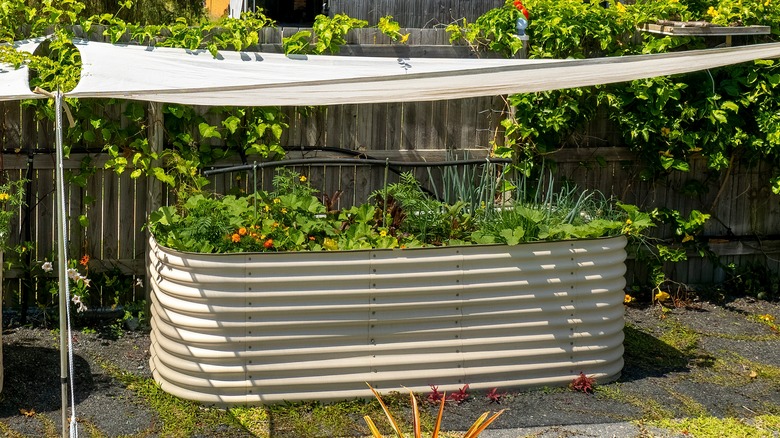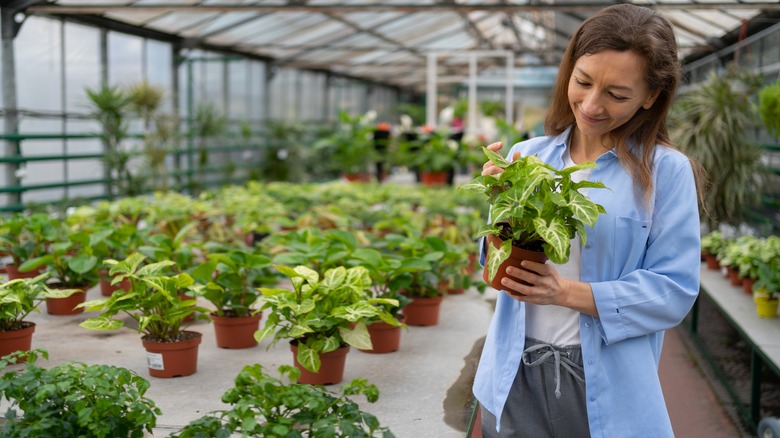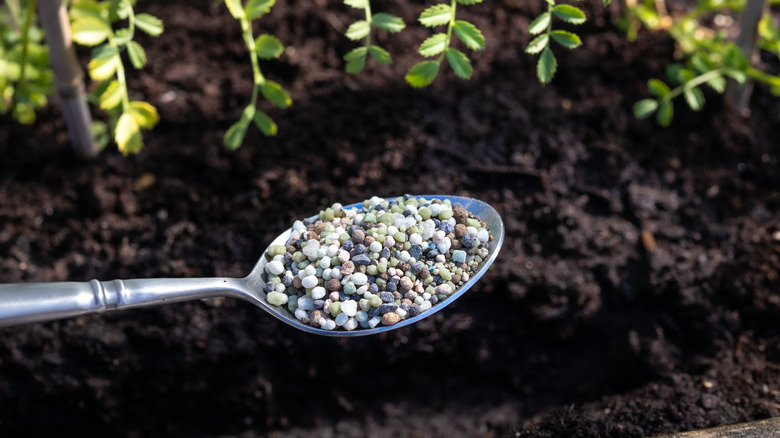5 Tips For Protecting Your Garden In A Heatwave
When the weather is really hot and sunny outside, you could run the risk of sunburn, heat stroke, and dehydration if you don't take the proper precautions in order to protect yourself. By wearing sunscreen to block the harmful rays of the sun and drinking plenty of water, you can help to keep yourself cool and hydrated on really hot days. But if you think you're the only one who has a tough time when the temperatures start to rise, just think about what your garden is going through.
In extremely hot weather, your garden could show signs of stress. With higher temperatures, the soil where your plants are growing can get hotter, and this can have a negative impact on how they develop, according to the Institute of Agriculture and Natural Resources at the University of Nebraska-Lincoln. The higher the temperature of the soil, the more likely it is that the induced stress will affect not only the overall production of the plant but will also lower photosynthesis and be detrimental to the root growth. So if you live in a warmer climate and you are expecting an extended period of hot weather, then it is important to pay extra attention to your garden. Luckily, there are plenty of ways to protect your green space so they can not only survive the warm conditions ahead but thrive as well. Let's take a look at the helpful tips you can use to keep your plants safe when the heatwave hits.
Water your garden strategically
At first glance, you might think the plants in your garden should be able to withstand whatever is thrown at them. A little extra heat and sun can't be a bad thing after all, right? However, your plants are extremely responsive when the temperature of the surrounding air or soil rises. As soon as temperatures rise over 86 degrees, your plants start to stress out, according to the UC Marin Master Gardeners. Without proper evaporation, the leaves of your plants will curl into themselves and start to wilt. This is why you must take charge and ensure that your garden is getting enough water so that it can last through the hot weather.
To keep the soil moist, you must stick to a regular watering routine, although you may need to be strategic when it comes to timing. If you are expecting hot weather ahead of time, it's best to water your garden first thing in the morning, before the sun rises to its highest point. Water your garden at the base of the stems so that lingering water left on the leaves won't burn throughout the day. Ensure that you are giving your garden enough water to reach deep within the soil, but not too much otherwise, it may waterlog the plants. When the sun has set for the day, you can revisit your patch and water it again so that it is kept moist throughout the night until you return in the morning.
Add some mulch
One sure way to keep the soil in your garden protected and help it to retain the moisture underneath is to top it off with some mulch. Mulch can be many things — when it is in the wild, mulch can be fallen bark, twigs, or leaves that have settled on the forest floor. This eventually breaks down, and the nutrients help to make the soil fertile. When in your backyard garden, you can purchase mulch from any garden center, where it's generally composed of various types of wood chips, or it can be produced yourself using elements from your composter or even manure from certain animals, as per Almanac. Whatever it is you choose to use, once sprinkled around your garden on top of the dirt you have, it can be the perfect defense against dry, hot soil.
If you have plants in your garden that have a shallow root system, they can be the ones that are most susceptible to higher atmospheric temperatures. By laying down a generous helping of mulch, you can ensure that it will slow down the evaporation process in the soil and assist in the soil's ability to retain the water that you have supplied for it. Other benefits to putting down organic mulch in your garden are that when it breaks down, it passes nutrients through and enriches the soil below. Also, it aids to stop the dirt from eroding and becoming too compacted, as well as deterring weeds from growing.
Create some shade
Although it is extremely important that your plants get plenty of sunshine throughout the day, there can be such a thing as too much sun. That's why if you want to help out your little green buddies and ensure that they don't burn, you can create your own shade for them to hide under. Before you start thinking about what amount of shade your garden needs, it helps to determine the amount of sun that your plants require, then monitor how much light they're already getting and at what time of day.
If the plants you have in the backyard are primarily in easy-to-move pots, then it can be as simple as placing them under an awning or umbrella when the sun is at its highest point. That way, the plants can get the amount of sun they need and spend the rest of the afternoon safe from burning or overheating. However, if your garden is already plotted out, but it is obviously getting more sun than it requires, that is when you have a few options to create the perfect protection. For permanent shade, you can construct a structure using metal poles with a large canopy overtop, or if your garden happens to be beside a chain link fence, then you can attach privacy screens that can double as shade, as per Terroir Seeds. For something more temporary, you can cast a cooling shadow by using a white bedsheet and some poles to attach it to.
Choose your plants wisely
If you live in a particularly hot climate then it can be beneficial to take some time and research the types of plants or vegetables that would thrive in such conditions. The last thing you want to do is stock your garden with plants that prefer cooler temperatures and then suffer the disappointment when they don't grow to their full potential. Annual flowers such as sweet peas and pansies and vegetables like broccoli, kale, and cauliflower don't tend to like hotter conditions, so it would be best to stay away from these types of plants unless you're able to control their environment more carefully, according to Gardener's Supply Company.
But don't fret and turn in your trowel quite yet, because there are plenty of heat-loving plants available that would look stunning in any garden. Veggies like tomatoes, corn, squash, and peppers can take the heat, and so can a variety of flowers like Mexican sunflowers, portulaca, and cosmos, as per Birds & Blooms. Obviously, this doesn't mean that because these plants can withstand warmer conditions, you can let them fend for themselves. It's quite the contrary. You should still stick to a plan of early morning and late evening watering to ensure that the soil stays moist and make certain that there's adequate shade if the plant needs it. However, by choosing plants that are better suited for warmer climates, you are certainly increasing your success of having a garden that stays beautiful all summer long.
Don't skip feeding your plants
While making sure the plants in your garden have all the water they need, you must also check that the overall health of your patch is top-notch. To ensure that the plants aren't stressed by the heat, it's important to keep the soil jam-packed with nutrients. This will help to boost the immune system of your garden, so they're able to fight through the hot weather.
Using fertilizers that are rich in nitrogen, phosphorus, and potassium can help to improve the health of your plants, according to the University of Minnesota Extension. Nitrogen contributes to the overall well-being of your plants and, when balanced perfectly, can positively affect your garden from root to fruit. Phosphorus aids the plant cells, and potassium ingredients assist in the addition of further growth. If you are expecting a particularly hot summer, then make sure you use either granulated or liquid fertilizers at the beginning of the season. That way, you can have nutrient-rich soil from the get-go and not risk shocking your plants or vegetables by introducing fertilizers in the middle of a heatwave. According to The Guardian, there are also other products available that can help your garden through a hot spell. A polymer coating could be added to protect the leaves from harmful fungi as well as the sun's rays. Also, the use of seaweed-rich plant tonics and moisture-attracting products in the soil could help the roots of the plants to easily access water and nutrients.
